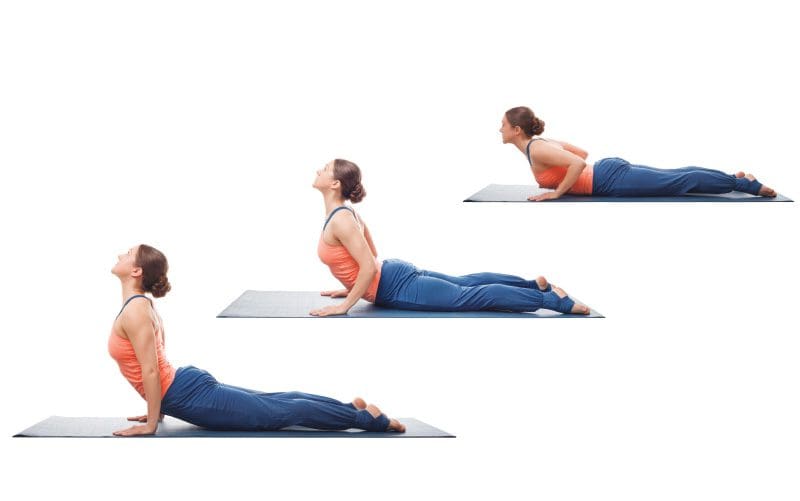
Bhujangasana Cobra Pose – Yogapedia
Bhujangasana, or cobra pose, owes its name to the cobra snake and the position it adopts when attacking. As one of the most classic and fundamental yoga positions, it is commonly used to transition to other postures in sun salutation, as well as to link different postures in a flow.
Like other posterior flexion postures, bhujangasana has its deepest effect on the lumbar spine. Please remember that observation is fundamental to understanding and growth as you practice this yoga pose, as in any other aspect of your life.
Benefits of the corpse pose
Physically
Provides flexibility.
Irrigates the spine with blood.
Tones the spinal cord.
Strengthens the arm and wrist muscles as well as the glutes.
Coupled with breathing, it gives a gentle massage to the lower back and inner organs.
Improves functions of the adrenal glands and kidneys.
Benefits the sympathetic and parasympathetic system, and functioning of the thymus gland and the heart.
Tones the pectoral muscles, creates space in the rib cage and stretches and revitalizes the abdominal muscles.
Mentally
The cobra posture provides a sensation of empowerment. As you press firmly the palms of your hands on the mat and emerge confidently from the ground, you display and open your chest, projecting self-trust and receptivity.
Emotionally
As your chest is lifted, your heart opens, creating a feeling of stress reduction and anxiety relief. Expansion of your lungs gives your body more oxygenation, translating to a deep feeling of clarity and space. You can give yourself permission to welcome more emotions to your attention.
Energetically
The cobra pose awakens kundalini, the divine cosmic energy that fosters self-realization, creativity, joy, peace and spiritual realization.
To be mindful
Do not practice this pose if you have carpal tunnel syndrome, or if you have any neck, wrist or spine injuries.
Avoid during pregnancy.
Practice self-respect by not pushing your back beyond your limit.
How to do the cobra pose
Begin by lying face down on the floor with the legs extended behind you. Gently press the top of your feet to the mat. Keeping the heels together causes a stretching of the external sciatic nerve, but this may cause compression of the lower back. To avoid this when first practicing the cobra pose, try keeping your feet separated until you become familiar with the posture.
Place the hands under your shoulders with fingers spread and pointing forward. Press the elbows into the sides of your body and take a moment to distribute the weight of your body, evenly pressing down through your feet, pubic bone and hands.
Inhale as you lift your head and chest off the floor. Exhale as you draw the shoulders back away from your ears and the heart forward. At this point, keep your gaze towards the floor; if you don’t sense any tension in your neck, go ahead and gaze up. Up to this point, you are in the low cobra variation.
Inhale as you keep lifting your chest; straighten your arms only as much as your body permits. Do not force the back to bend by pushing. Focus more on allowing the curve of your spine to happen as a natural result of lifting your chest and extending your spine. Remember to keep pressing the elbows to your sides. Take deep and long inhales, and when you exhale, do it slowly with absolutely no hurry. Hold for six breaths.
To release the posture, lower your chest and forehead to the floor along with an exhalation. Pause and breathe in. As you breathe out, transition into the child’s pose (balasana), moving the hips to your heels, extending the arms in front of you and resting your forehead and arms on the mat. Hold for as long as it feels soothing to you.
Cover Story – Costa Rica is the Happiest Country in the World… Why?
Costa Rican Army Abolished: One more reason for happiness?
Feature Article – Living longer in Costat Rica Blue Zone
Costa Rica Yoga and Wellness Retreats
Yoga Wisdom – Power of Yoga: Yamas and Niyamas
Natural Medicine – CBD Oil: Nature’s Miracle Cure?
Mindfulness: Natural High: Benefits of Nature
Psychological Well Being – Counseling Help in Costa Rica
Eat Well: Costa Rica Superfoods – Nutrient Dense Food
Costa Rica Medical Tourism
Costa Rica Dental Tourism: Veneers – Reason to Smile
Ecotourism in Costa Rica: Sustainable Tourism
Ecotourism Pioneer: Rafael Gallo – Ríos Tropicales
The Osa Peninsula
Ecotourist Road Trip: Sarapiquí
Ecolodges in Costa Rica
Caminos de Osa: Tourism that is helping Costa Ricans
CST Being Green Matters to Diamante Eco-Adventure Park
Grow Sustainably, Build & Live Sustainably in Costa Rica
Behind the Image: Photography as Ecotourism
Building Green and Prove it in Costa Rica
Costa Rica Sustainable Development: Ever Greener
Costa Rica’s indigenous Communities and Indigenous Tribes
